Wednesday Jan. 10, 2007
The first day of class.
We first briefly discussed the Course
Information
handout. Note the various options you have for purchasing a copy
of the course textbook. You should try to purchase a copy of the
photocopied
Classnotes (in the bookstore) right away as we will probably be using
some of
them in class on Friday.
Next we looked at the Writing
Requirements
handout. You should be thinking about which of the experiments
(or book or scientific paper reports) you would like to do so that you
can sign up in class on Friday. Distribution of the materials
for
the first experiment could begin as early as Wednesday next week (Jan.
17).
Your grade in this class will depend on your quiz scores, how much
extra credit you earn, your writing grade, and (perhaps) your
score on the final exam. A sample grade report from the Fall
2006 NATS 101 class was shown.

Don't worry about what all of this means at this point, it will become
clearer as the semester progresses. Do note, however that, even
with C grades on all the quizzes and the final exam, this student ended
up with a B in the course. This is because the student earned
quite a bit of extra credit and had a high writing grade.
We will
start this course in Chapter 1 of the textbook. Before reading
the first few pages in Chapter 1 (see the Reading Assignments link on the class
home page) you should try to guess what you might find covered
there. The following question might suggest some things.

Here are responses from students in class.
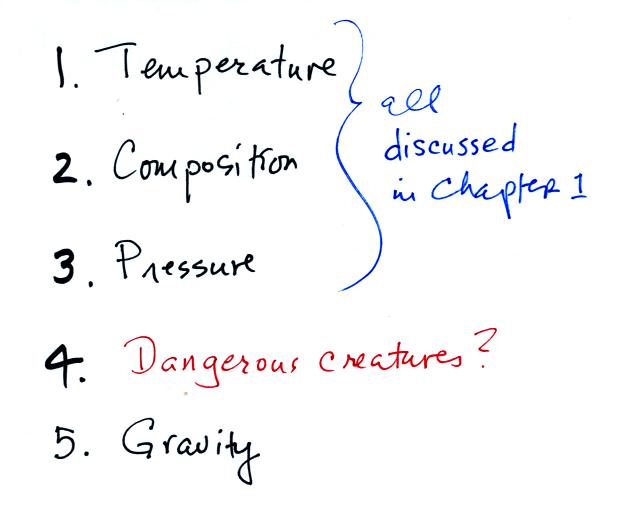
The first three characteristics are discussed in Chapter 1.
What is the most abundant gas in the atmosphere? Some of that
material, in liquid form, was poured from a thermos into
a styrofoam cup.
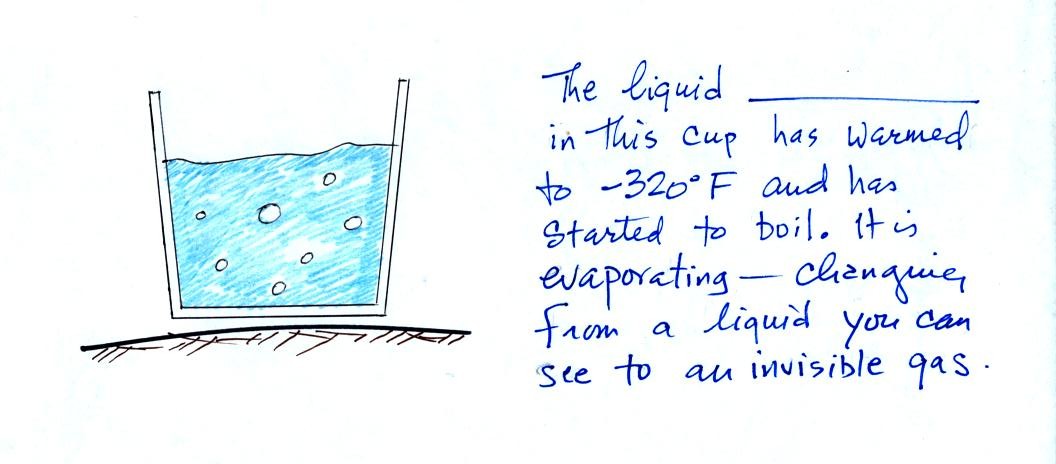
The liquid (and the most abundant gas in the atmosphere) was
nitrogen (you can fill in the blank above with the word
nitrogen). You can see liquid nitrogen. Once it has
evaporated and turned into a gas it is invisible.
Oxygen is the second most abundant gas in the atmosphere. Liquid
oxygen is supposed to be blue, not clear like liquid nitrogen.
Click here
to see a photograph of some liquid oxygen.
Here is a list of the 5 most abundant gases in the earth's atmosphere:

Water vapor and argon occupy 3rd and 4th place, but they
sometimes switch places.
The variable concentration of water vapor means it is sometimes more
abundant & sometimes less abundant than argon.
Water plays an important role in the formation of clouds,
storms,
and weather. Meteorologists are very interested in knowing how
much water vapor is in the air at a particular place and time.
The dew point temperature provides a measure of the amount of water
vapor in the air.
The figure below gives a rough equivalence between dew point
temperature and percentage concentration.
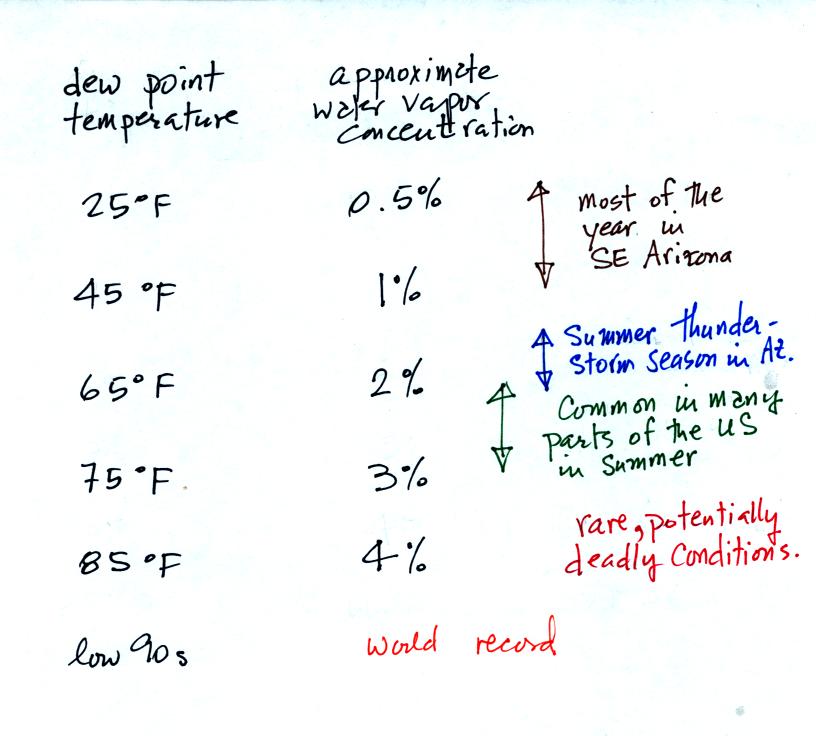
Think of the dew point as being just a number. When
the value
is low the air doesn't contain much moisture. The higher the dew
point value, the more water vapor in the air.
The air has been pretty dry in Tucson for the last several days with
dew point temperatures in the teens. You might expect to see an
increase in the dew point in the next few days as wetter unsettled
weather moves in.
Click here
to see current dew point temperatures across the U.S.
You can see liquid water, just as was true with the liquid
nitrogen. Once water evaporates and forms water
vapor it is invisible. When you see steam, fog, or a cloud
you are seeing small drops of liquid water or small ice crystals not
water vapor.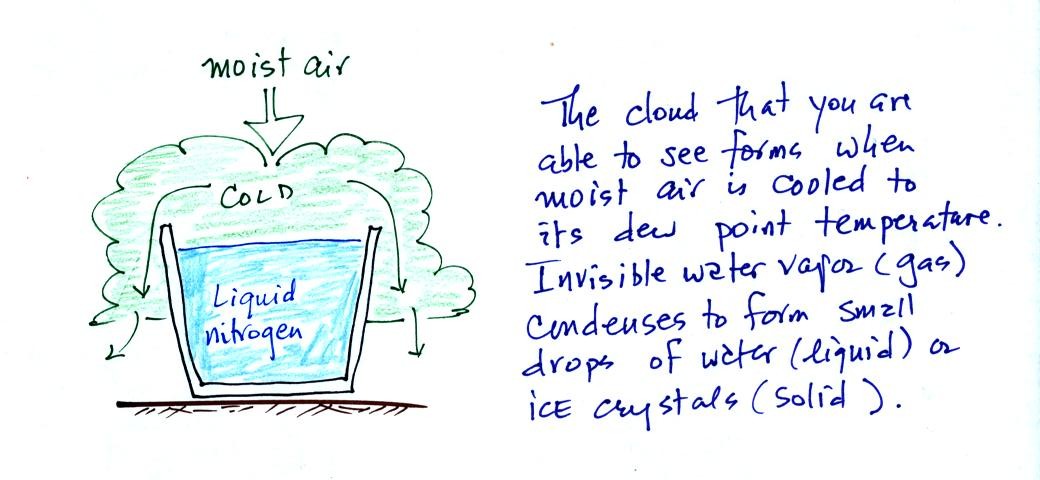
The dew point temperature tells you how much you must cool moist
air in
order for a cloud to form.
Here are
some other gases found in the earth's atmosphere that we
will cover (this list was not
covered in class). Most are found in very low
concentrations but that
doesn't
mean they are not important.
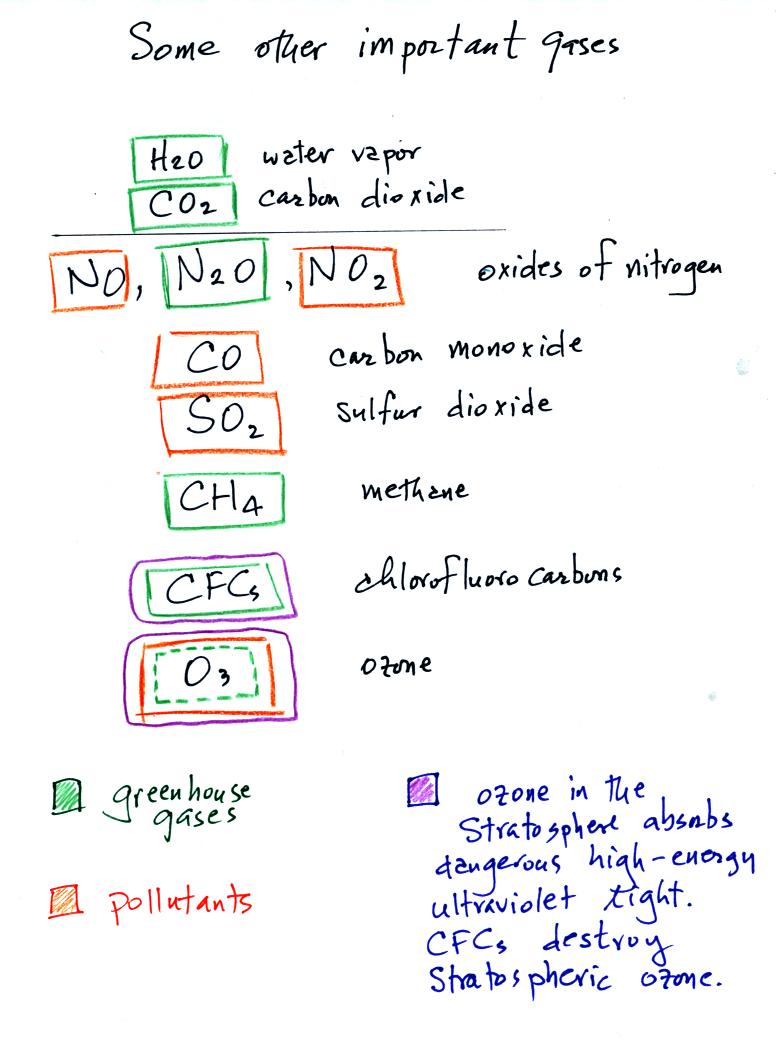
Water vapor, carbon dioxide, methane, nitrous oxide (N2O
=
laughing gas),
chlorofluorocarbons, and ozone are greenhouse gases. We will
cover the greenhouse effect in more detail when we get to Chapter
2. The "natural" greenhouse effect has a beneficial role on the
earth. Without the greenhouse effect average surface temperatures
on the earth would be much colder than they are now (0o F
rather than
about 60o F ). Atmospheric
concentrations of many greenhouse gases are increasing however.
This could enhance or strengthen the greenhouse effect and cause global
warming which could have many detrimental effects.
Carbon monoxide, nitric oxide, nitrogen dioxide, ozone, and sulfur
dioxide are some of the main air pollutants.
Ozone in the stratosphere absorbs dangerous high energy ultraviolet
(UV) light coming from the sun. Without the protection of the
ozone layer life as we know it would not exist on the surface of the
earth. Chlorofluorocarbons are of concern in the atmosphere
because they destroy stratospheric ozone.
The following material wasn't covered
in class either.
Our present atmosphere is very different from the earth's
original atmosphere.

The earth's first atmosphere was composed mainly of hydrogen
and
helium.
These light-weight gases escaped into space and were lost. The
next atmosphere was built up of gases emitted during volcanic
eruptions, mostly water vapor, carbon dioxide, and nitrogen. As
the earth began to cool the water vapor condensed and began to create
oceans. Carbon dioxide dissolved in the oceans and was slowly
turned into rock. Much of the nitrogen remained in the atmosphere.
Note the volcanoes didn't add oxygen to the atmosphere.

The oxygen is thought to have first come from
photodissociation of
water vapor and carbon dioxide by ultraviolet light (the high energy
radiation splits the H20 and CO2 into
pieces). The O and OH react
to form O2 and H.
Once O2 begins to accumulate in the air it can react with O
to form
ozone, O3. The ozone then begins to absorb ultraviolet
light,
life forms can move from the oceans (which would absorb UV light in the
absence of ozone) onto land. Eventually plants and photosynthesis
would become the main source of atmospheric oxygen.









